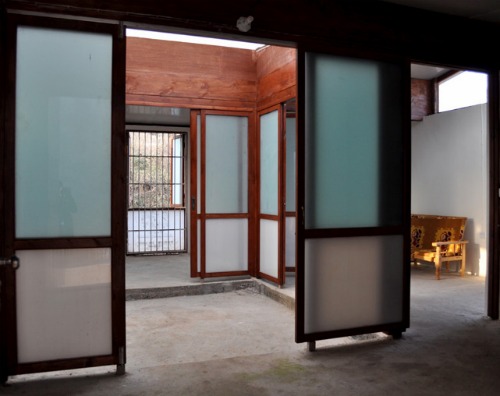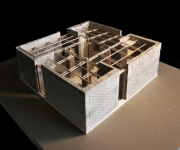 The winning design.Photo: Ying chee ChuiLots of things cost $1,000 — a sweet new bike or a svelte 11″ MacBook Air, for instance. But a house? Even that brilliant 16-year-old punk who built a tiny house in his parents’ backyard had to shell out $12,000 for his shack. I must be kidding, right?
The winning design.Photo: Ying chee ChuiLots of things cost $1,000 — a sweet new bike or a svelte 11″ MacBook Air, for instance. But a house? Even that brilliant 16-year-old punk who built a tiny house in his parents’ backyard had to shell out $12,000 for his shack. I must be kidding, right?
Well, sort of. Two years ago, MIT architecture professors launched the 1K House Project, a design competition challenging students to come up with a home that could be built for $1,000. 14 designs emerged from the studio, and Ying chee Chui’s Pinwheel House came out on top.
A prototype of Chui’s house was recently completed in Mianyang in the Sichuan Province of China. The bill rang up to quite a bit more than $1,000: It cost $5,925 in total. But the project suggests that with a little investment, we can make well-designed, structurally sound homes available to even the poorest of the poor — a promising sign in a world where, if things continue as they’ve been, 900 million people will live in slums by 2020.
The Pinwheel House consists of four rectangular rooms arranged like a pinwheel around a square central courtyard. And the house is both adaptable and modular. Inside, movable screens separate rooms of different functions. And each rectangular section is constructed in the same way, minimizing the amount of labor and learning that goes into the building process. As families grow in size or affluence, they can buy another module and add it on to their existing floor plan.
The design is specifically aimed at the world’s poor, as it allows families to start small and expand as money allows. While many shacks and shanties grow this way, if each addition isn’t designed and built properly, this can lead to structural issues that can arise during a natural disaster. Additions to Pinwheel Houses shouldn’t suffer from these problems.
And natural disasters are part of the plan: The walls of the Pinwheel House are made of hollow brick reinforced with rebar, while the wooden-beam roof adds additional strength to the structure. It is designed to withstand a magnitude 8.0 earthquake. Given the devastation wrought by shoddy building in the wake of Sichuan’s magnitude 8.0 earthquake or Haiti’s magnitude 7.0 quake, that’s a reassuring footnote to a clever design.
The 1K House was inspired by MIT’s One Laptop Per Child project, which sought to build a portable, rugged computer for developing countries that would cost $100. The laptop project never quite reached its price target — parts simply cost too much, and its current price is estimated at just over $200. The Pinwheel House’s cost overruns reinforce the difficulties of building high-quality products at low costs. Chui said part of the added expense was because the prototype was around 300 square feet larger than his original design. (Housing bloat is something most Americans should be familiar with.) But trimming the footprint to 500 square feet would drop the costs to around $4,000, he said. Building these houses in bulk would trim even more fat off the price.
Even if the Pinwheel House is able to reach a sought-after base price of $1,000, it’ll still be a long reach for the 1.3 billion people that live on less than $1.25 per day. Perhaps governments with a little cash on hand — or a lot, like China — will take advantage of the low cost and high quality to invest in housing for their poorest citizens.




